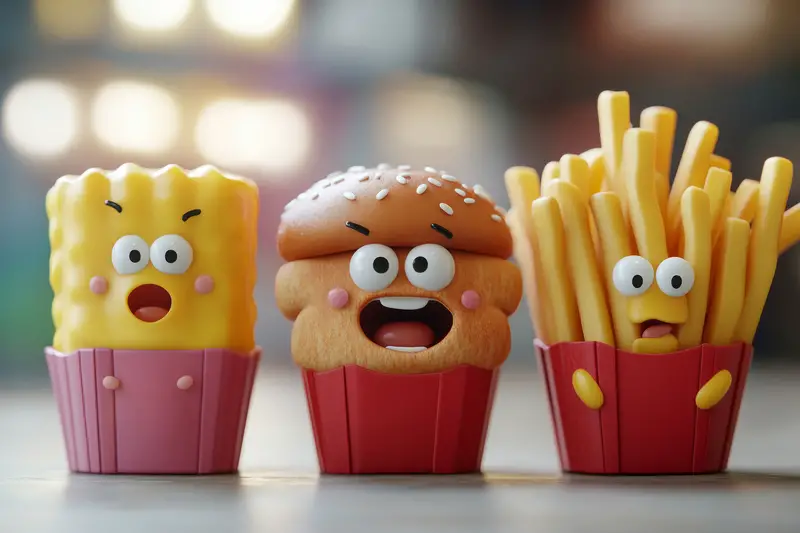Remember when fast food commercials were filled with quirky characters instead of just close-up shots of burgers? If you grew up watching TV in the 80s and 90s, you probably had a favorite fast food mascot. While Ronald McDonald has managed to stay in our collective memory, many others have faded into obscurity. These marketing icons once helped define our favorite fast food chains but have since disappeared from the spotlight. Ready for a trip down memory lane? Let’s look at some fast food mascots that time (and marketing departments) forgot.
The Noid almost destroyed Domino’s pizza
The Noid was Domino’s Pizza’s red-suited villain with rabbit-like ears who tried to make your pizza cold and soggy. Created in 1986, this impish character appeared in commercials attempting to sabotage pizza deliveries. The message was simple: Domino’s delivered so quickly that they could “avoid the Noid.” Kids loved the character so much that Domino’s even released a video game called “Yo! Noid” for the Nintendo Entertainment System, and the mascot became one of the most recognizable advertising icons of the late 1980s.
Unfortunately, the Noid met an unexpected end after a bizarre real-life incident in 1989. A mentally ill man with the last name “Noid” took Domino’s employees hostage because he believed the ads were making fun of him. This tragic event prompted Domino’s to retire the character by 1995. While Domino’s has occasionally brought back the Noid for limited promotions in recent years, many people have completely forgotten this once-popular mascot who nearly destroyed the pizza chain’s reputation through an unfortunate coincidence.
Speedee was Mcdonald’s first mascot
Before Ronald McDonald became the face of the world’s largest fast food chain, there was Speedee. This winking, pot-bellied chef with a hamburger for a head represented McDonald’s “Speedee Service System” in the 1950s, promising customers quick service and fresh food. Speedee appeared on signs, packaging, and early McDonald’s restaurants, becoming the first visual representation of the brand. The character reflected the company’s original focus on efficiency and its revolutionary assembly line approach to fast food preparation.
Speedee was officially retired in the 1960s when McDonald’s shifted to the now-famous Golden Arches logo and introduced Ronald McDonald. The change came as the company expanded nationally and wanted a more family-friendly mascot that could appeal directly to children. While a few vintage McDonald’s locations still feature Speedee in their signage, most people have no idea that this hamburger-headed chef preceded the famous clown. Speedee represents a fascinating glimpse into McDonald’s humble beginnings before it transformed into the global fast food giant we know today.
Mac tonight sang his way into customers’ hearts
In 1986, McDonald’s introduced Mac Tonight, a suave, piano-playing character with a crescent moon for a head who wore sunglasses at night. This cool crooner was designed to promote McDonald’s dinner hours when the chain was primarily known for breakfast and lunch. Singing parodies of Bobby Darin’s “Mack the Knife” while perched at a piano, Mac Tonight had a distinct jazz vibe that appealed to adults rather than children. His commercials showed him playing piano on rooftops with city skylines behind him, creating a sophisticated atmosphere for fast food.
Mac Tonight’s career was cut short when Bobby Darin’s estate sued McDonald’s for unauthorized use of the song. The character disappeared from American television by 1989. Interestingly, Mac Tonight continued to appear in advertisements in some international markets well into the 1990s. Despite his brief time in the spotlight, Mac Tonight developed a cult following and remains one of the most visually distinctive fast food mascots ever created. The moonheaded musician represented a rare attempt by McDonald’s to specifically target adult customers during evening hours.
The Burger King Kids Club made diversity cool
In the early 1990s, Burger King launched the Kids Club Gang, a diverse group of cartoon kids with different backgrounds and personalities. Led by a cool kid named Kid Vid, the gang included characters like Wheels (who used a wheelchair), IQ (the smart one), Jaws (with braces), Snaps (who loved photography), Lingo (who spoke multiple languages), and J.D. (the sporty girl). This multicultural group was actually ahead of its time, promoting diversity and inclusion when most other children’s marketing wasn’t particularly concerned with representation.
The Kids Club was hugely popular, with over 5 million children signing up for the free kids club membership in the first few years. Members received special meals, toys, and birthday gifts. Burger King eventually phased out the Kids Club characters in the early 2000s, replacing them with various other promotions and eventually the “Honbatz” characters in 2005. Today, many 90s kids have fond memories of the Kids Club Gang, but younger generations have never heard of these pioneering characters who made fast food marketing more inclusive.
The Taco Bell chihuahua’s popularity wasn’t enough
In 1997, Taco Bell introduced a Spanish-speaking Chihuahua who proclaimed “¡Yo quiero Taco Bell!” (“I want Taco Bell!”). Voiced by actor Carlos Alazraqui, this tiny dog became an overnight sensation. The Chihuahua, named Gidget, appeared in numerous commercials and her catchphrase became part of pop culture. Taco Bell sold millions of stuffed toy versions of the dog, and the character appeared on t-shirts, hats, and other merchandise. For a brief moment, this small dog was one of the most recognizable advertising characters in America.
Despite the Chihuahua’s popularity with many customers, Taco Bell discontinued the campaign in 2000. Several factors contributed to the mascot’s retirement, including criticism that the character relied on Mexican stereotypes and a lawsuit from two men who claimed they had presented the idea to Taco Bell before the campaign launched. Most significantly, Taco Bell’s sales actually declined during the Chihuahua campaign, suggesting that while people remembered the ads, they weren’t necessarily buying more tacos. The beloved dog mascot teaches an important lesson in advertising: creating a memorable character doesn’t always translate to increased sales.
Arby’s talking oven mitt got burned
In the early 2000s, Arby’s introduced a talking oven mitt as their spokesperson. This unusual character, voiced by Tom Arnold, was designed to highlight the fact that Arby’s roasted their beef rather than frying it. The white mitt had googly eyes, a mouth, and appeared in commercials performing various tasks while promoting Arby’s sandwiches. The character represented a significant departure from traditional mascots, as Arby’s literally turned a kitchen tool into a personality. The mitt appeared in numerous TV spots and became Arby’s primary advertising vehicle.
Despite the novelty of the concept, customers never fully embraced the Oven Mitt. After just a couple of years, Arby’s retired the character and moved on to other marketing approaches. Marketing experts have suggested that while the mitt was memorable, it didn’t create a strong enough emotional connection with customers or effectively communicate what made Arby’s unique. Today, many people would struggle to remember this short-lived mascot, making it one of the more obscure entries in fast food marketing history. The Oven Mitt serves as a reminder that being different isn’t always enough to create a lasting impression.
The Quiznos Spongmonkeys were weird on purpose
In 2004, Quiznos launched one of the strangest advertising campaigns in fast food history. The Spongmonkeys were bizarre, rat-like creatures with human eyes and crooked teeth who sang off-key about loving Quiznos subs. Created by Joel Veitch, these creatures originally appeared on the internet before Quiznos adopted them. The commercials featured these odd animals screeching lyrics like “We love the subs! ‘Cause they are good to us!” while floating against surreal backgrounds. These ads deliberately embraced the weird, random humor that was beginning to define internet culture in the early 2000s.
The Spongmonkeys campaign was highly polarizing. While younger audiences appreciated the absurdist humor, many older customers were confused or even disturbed by the creatures. Quiznos retired the campaign after less than a year, though the Spongmonkeys have occasionally returned in limited promotions. This short-lived campaign represents an early attempt by a major food chain to leverage internet culture for mainstream advertising. While the Spongmonkeys are mostly forgotten today, they helped pave the way for the strange, meme-inspired marketing that has since become commonplace.
Dennis The Menace served ice cream at Dairy Queen
From the 1970s through the early 2000s, Dairy Queen used the famous comic strip character Dennis the Menace as their official mascot. This mischievous, blonde-haired boy in overalls appeared in advertisements, on signage, and on kids’ meal packaging. Dennis was the perfect embodiment of DQ’s family-friendly image, appealing to both parents who grew up with the comic strip and their children. The partnership made perfect sense – what could be more wholesome than an iconic American comic character enjoying ice cream treats? Dennis appeared in numerous commercials promoting Blizzards, Dilly Bars, and other frozen desserts.
In 2002, Dairy Queen’s licensing agreement with the owners of Dennis the Menace expired, ending the long-running mascot relationship. After three decades of association with DQ, Dennis moved on, and the ice cream chain switched to other marketing approaches. Many younger customers today have no idea that this famous comic character once represented Dairy Queen. This partnership represents one of the longest-running licensing agreements between a fast food chain and an established character. The collaboration was so successful that many people from that era still associate Dennis with Dairy Queen’s treats.
Pizza Hut’s pizza head was a Mr. Bill Parody
During the 1990s, Pizza Hut featured a character called Pizza Head in a series of stop-motion animated commercials. Pizza Head was literally a slice of pizza with eyes and a mouth who was constantly tormented by a menacing pizza cutter named Steve. These ads were a direct parody of the popular “Mr. Bill” sketches from Saturday Night Live, where a clay figure was repeatedly crushed, smashed, or otherwise destroyed. Pizza Head would yell “Oh no!” in the same high-pitched voice as Mr. Bill whenever Steve the pizza cutter appeared to slice him up. These commercials were especially popular with kids and teenagers.
The Pizza Head commercials ran from 1991 to 1999, making them one of the longer-running fast food campaigns of the decade. Despite their popularity during that time, Pizza Head has been largely forgotten by today’s consumers. The character represented a specific era in advertising when references to pop culture were becoming increasingly common in fast food marketing. Pizza Head never had merchandise or toys associated with him, which may explain why this mascot hasn’t maintained the same nostalgic appeal as some others from the same period. Still, for 90s kids, Pizza Head remains a fond, if somewhat bizarre, memory.
Looking back at these forgotten fast food mascots reminds us how much marketing has changed over the decades. Today’s fast food ads focus more on the food itself rather than fictional characters. But for those of us who grew up with these quirky mascots, they’re a nostalgic reminder of simpler times when a moonheaded pianist or a pizza-hating villain could make us crave a burger or pizza. Who knows? Maybe some of these forgotten characters will make comebacks as companies tap into our nostalgia for advertising’s golden age.

